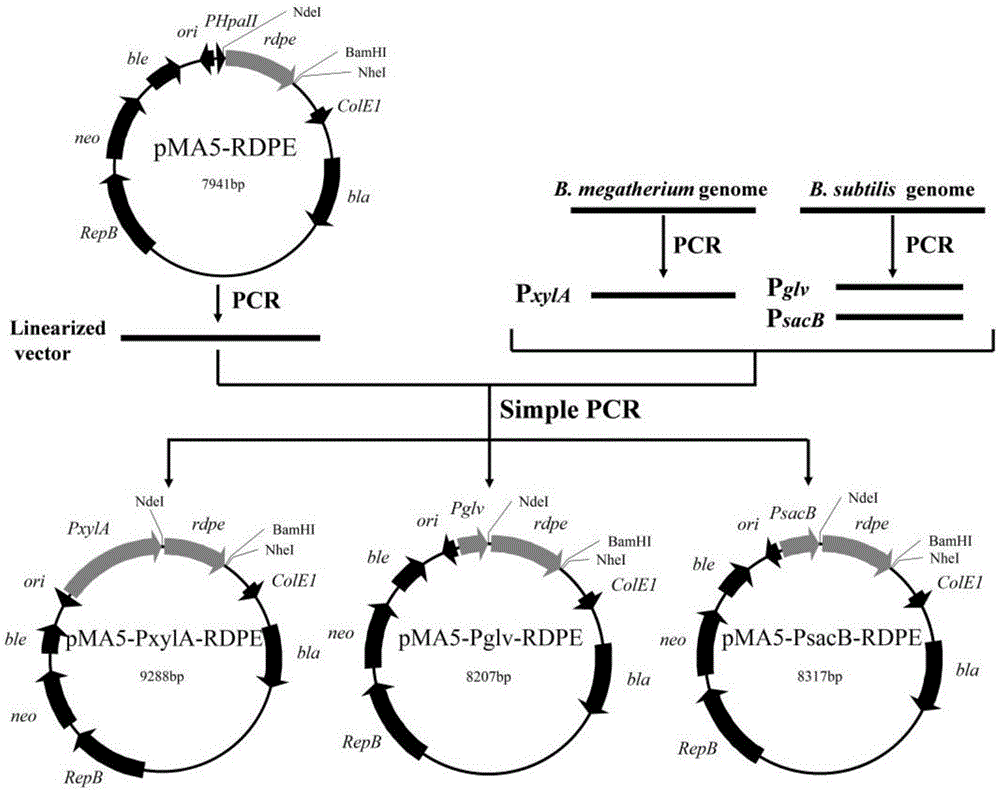Genetic engineering strain capable of effectively secreting D-psicose 3-epimerase and construction method and application thereof
A technology of genetically engineered strains and epimerase, which is applied in the direction of genetic engineering, isomerase, and microbial-based methods, can solve the problems of increasing the complexity of product purification and increasing the cost of protein production, so as to reduce production costs , high-efficiency secretion and expression, and the effect of simplifying the protein purification process
- Summary
- Abstract
- Description
- Claims
- Application Information
AI Technical Summary
Problems solved by technology
Method used
Image
Examples
Embodiment 1D
[0026] Example 1D- Obtaining of Psicose 3-epimerase Gene Fragment
[0027] According to the sequence of the DPEase coding gene rdpe derived from Ruminococcussp. Subsequent expression vector construction. The synthesized gene was connected to the pUC57 vector and named pUC57-RDPE.
Embodiment 2D
[0028] Example 2D-constitutive expression of psicose 3-epimerase
[0029] Plasmids pUC57-RDPE and pMA5 were subjected to NdeI and BamHI double enzyme digestion treatment respectively; the double enzyme digestion reaction conditions were 37°C water bath for 3h. Gel-recover the double-digested products to obtain the rdpe fragment with NdeI and BamHI restriction sites at both ends and the linearized pMA5 vector, and connect the two with T4 ligase in a refrigerator at 4°C overnight; The product was transformed into DH5α colonic competent cells, resistance screening was performed with ampicillin (100 μg / mL), positive clones were screened by colony PCR, and plasmids were extracted for sequencing verification. For plasmid construction results, see figure 1 , the constructed recombinant expression plasmid containing the rdpe gene was named pMA5-RDPE.
[0030] The constitutive expression plasmid pMA5-RDPE was transformed into 1A751 competent cells by Spizizen transformation method, s...
Embodiment 3D
[0032] Example 3D-Inducible expression of psicose 3-epimerase
[0033] xylose promoter P xylA Sequence, maltose promoter P glv sequence and sucrose promoter P sacB The sequences are shown in SEQIDNO.2, SEQIDNO.3 and SEQIDNO.4 respectively, and primers xylA-F / xylA-R, glv-F / glv-R and sacB-F / sacB-R were designed. Using xylA-F / xylA-R as primers and plasmid pHCMC04 as template, PCR was performed to obtain P xylA Fragment; using glv-F / glv-R and sacB-F / sacB-R as primers, and using the Bacillus subtilis 1A751 genome as a template to obtain P glv and P sacB fragment. Primers pMA5-RDPE-F / pMA5-RDPE-R were designed, and pMA5-RDPE was used as a template for PCR to obtain a linearized pMA5-RDPE vector fragment. The primer sequences described above are as follows:
[0034] XylA-F:5'-CAGCCTCGCAGAGCACACACTTTATGGGCGCGCCTTTCCCAGTCACGACGTTGTAAAAC-3'
[0035] XylA-R:5'-CAATAAGCGTAATAAATACCATATTTCATATGATTTCCCCCCTTTGATTTAAGTGATTTCC-3'
[0036] Glv-F:5'-CAGCCTCGCAGAGCACACACTTTATGGGCGCGCCCGCG...
PUM
 Login to View More
Login to View More Abstract
Description
Claims
Application Information
 Login to View More
Login to View More - R&D
- Intellectual Property
- Life Sciences
- Materials
- Tech Scout
- Unparalleled Data Quality
- Higher Quality Content
- 60% Fewer Hallucinations
Browse by: Latest US Patents, China's latest patents, Technical Efficacy Thesaurus, Application Domain, Technology Topic, Popular Technical Reports.
© 2025 PatSnap. All rights reserved.Legal|Privacy policy|Modern Slavery Act Transparency Statement|Sitemap|About US| Contact US: help@patsnap.com



